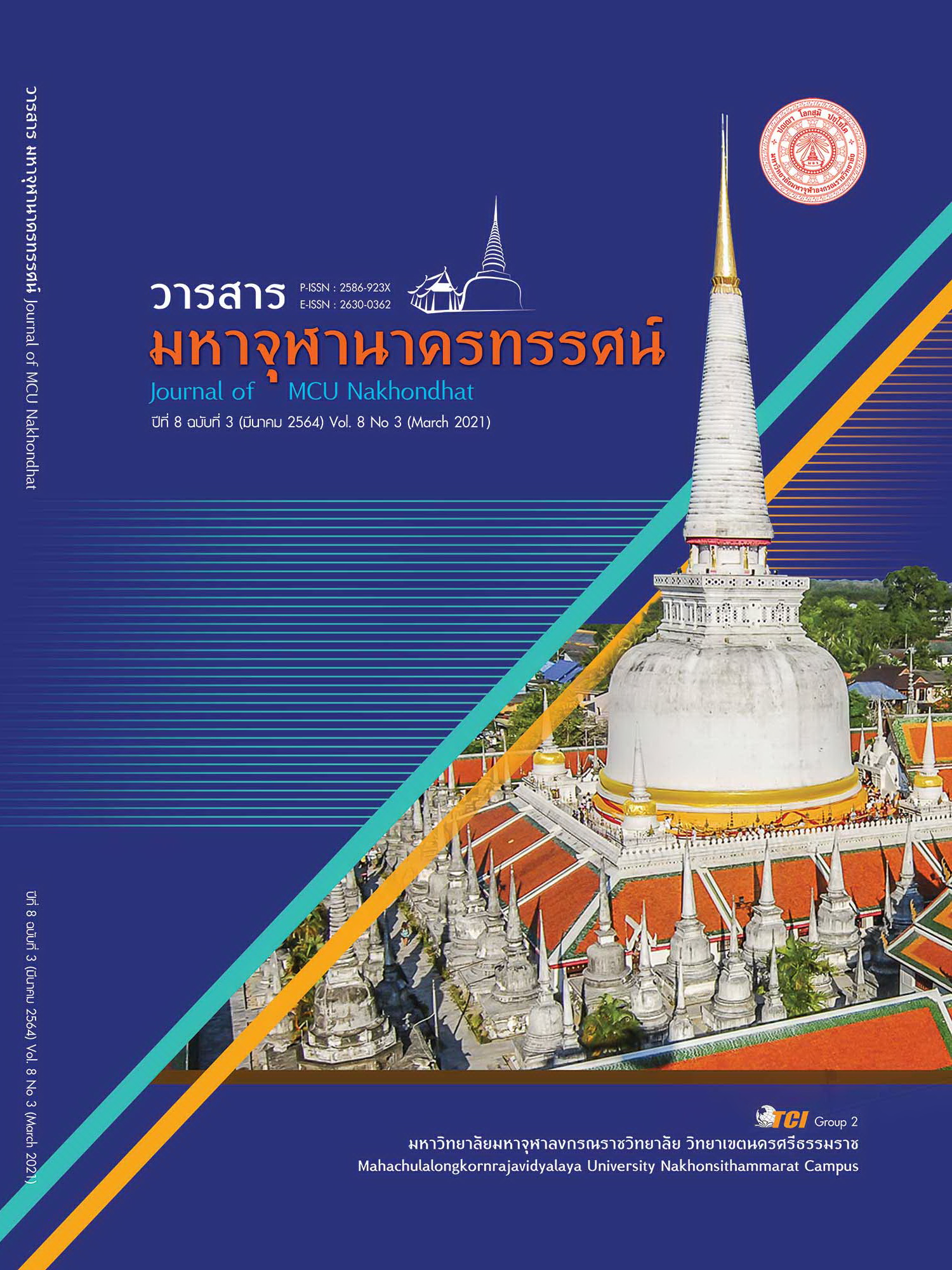THE MODEL OF MULTICULTURAL SOCIETY WITH UNCONDITIONAL RELIGION CREATING
Main Article Content
Abstract
The objectives of this research article were: 1) to study the context and the way of living together in diverse religious and cultural community in Nakhon Si Thammarat Province and 2) to present the model of multicultural society with unconditional religion creating in Nakhon Si Thammarat Province. This research was qualitative research (multiple cases study) in 5 communities in Nakhon Si Thammarat province. The research instrument were an in - depth interview and observation form and there were 60 key informants. The research results were: 1) The way of living together in diverse religious and cultural community in 5 communities were different in their own contexts and the way of living together. The community were varies based on the context of the area. They were multiculturalism, but they were in peace. People in the community are loving, living united, sharing together, understanding different belief and contexts, respecting each religion's beliefs, knowing how to treat each other, and building relationships in the community, and 2) The model of multicultural society with unconditional religion creating consisted of 4 elements that is called PALC as follow; 1) Paradigms of Community were as the thoughts and feelings of people in the community. This feeling was not separation, solidarity, and getting along well in religion, 2) Leader in religion and Local Wisdom Scholars were visionaries, morals, and role models for the community, 3) Activities and Lifestyles that were about volunteering activities for the community based on the principles of participation of people in the community. 4) Conflict Resolution that was the important tool in a multicultural society. In the multicultural society with unconditional religion, people in the community are in love, harmony, equalization, respecting of rights, honoring, maintaining the rules and regulations, and using “Makka” as a guideline or method to resolve conflicts
Article Details
References
ฉัตรชัย ศุกระกาญจน์. (2557). พระบรมธาตุนครศรีธรรมราชสู่มรดกโลก. วารสารราชภัฏสุราษฎร์ธานี, 1(1), 29-40.
ประจวบ ทองศรี. (2559). แนวทางการส่งเสริมการมีส่วนร่วมของผู้นำศาสนาเพื่อเสริมสร้างสันติสุขในพื้นที่สามจังหวัดชายแดนใต้. ใน รายงานสืบเนื่องจากการประชุมวิชาการระดับชาติ การบริหารการพัฒนาสังคมและยุทธศาสตร์การบริหาร ประจำปี 2559. สถาบันบัณฑิตพัฒนบริหารศาสตร์.
พระพรหมคุณาภรณ์ (ป.อ. ปยุตฺโต). (2555). พุทธธรรม ฉบับปรับปรุงและขยายความ. (พิมพ์ครั้งที่ 5). กรุงเทพมหานคร: บริษัท สหธรรมิก จำกัด.
พระมหาบุญเลิศ อินท์ปญฺโญ. (2559). สันติวิถีเริ่มต้นที่ชุมชน: กรณีศึกษาภูมิปัญญาท้องถิ่นในการสร้างสันติสุข ภาคเหนือของประเทศไทย. วารสาร มจร สังคมศาสตร์ปริทรรศน์, 5(2), 1-14.
พระมหายุทธนา นรเชฏโฐ และคณะ. (2560). ศึกษาวิเคราะห์หลักการอยู่ร่วมกันของสังคมพหุวัฒนธรรมในประเทศไทย: กรณีศึกษาชุมชนชาวพุทธและมุสลิมในชุมชนวัดท่าการ้อง ตำบลบ้านป้อม อำเภอ พระนครศรีอยุธยา จังหวัดพระนครศรีอยุธยา. วารสาร มจร พุทธศาสตร์ปริทรรศน์, 1(1), 40-61.
พูนสุข มาศรังสรรค์ และคณะ. (2561). เกณฑ์ชี้วัดความสำเร็จเกี่ยวกับกระบวนการสร้างสันติภาพขององค์กรและนักสันติภาพโลก. ใน รายงานวิจัย. สถาบันวิจัยพุทธศาสตร์ มหาวิทยาลัยมหาจุฬาลงกรณราชวิทยาลัย.
ศิริพัฒ พัฒกุล. (19 มิถุนายน 2563). รูปแบบการสร้างสังคมพหุวัฒนธรรมไร้รอยต่อทางศาสนา. (ขันทอง วัฒนะประดิษฐ์, ผู้สัมภาษณ์)
สำนักงานวัฒนธรรมจังหวัดนครศรีธรรมราช. (2559). รายงานผลการดำเนินภารกิจงานที่ได้รับมอบหมายจากสำนักเฝ้าระวังทางวัฒนธรรม สำนักงานปลัดกระทรวงวัฒนธรรมจังหวัดนครศรีธรรมราช. นครศรีธรรมราช: สำนักงานวัฒนธรรมจังหวัดนครศรีธรรมราช.
Chung, K. H. & Megginson, L. C. (1981). Organizational Behavior: Developing Managerial Skills. New York: Harper and Row.
Gultung, J. (1975). Violence Peace and Peace Research. Journal of Peace King. (8th ed.). Great Britain: Collins Clears Clear-Type.


